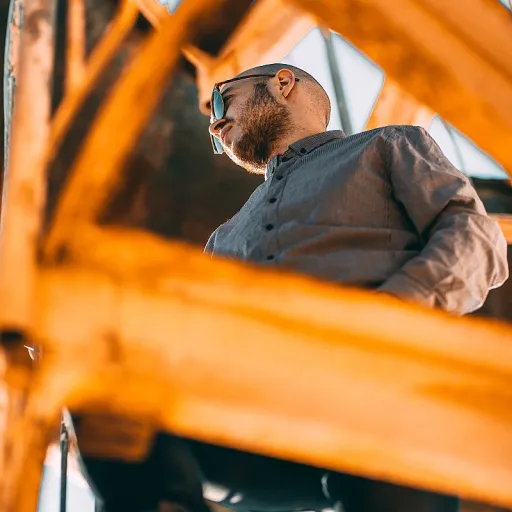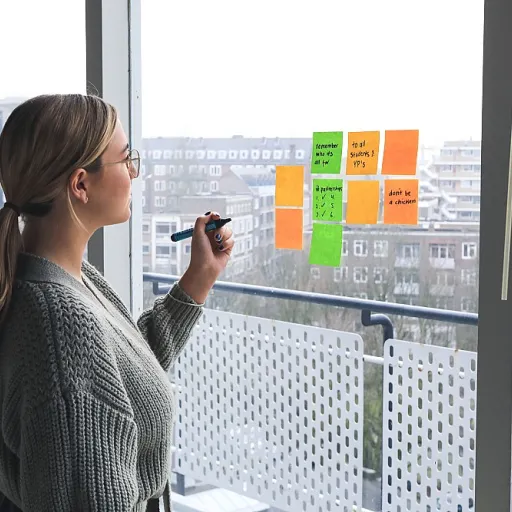
The role of design in work tech
{"Importance of Design in Work Technology Projects
The foundation of successful work technology projects relies heavily on the integration of effective design principles. Design serves as the basis for creating solutions that not only meet user needs but also align with the operational objectives of the organization. In this context, the role of design extends beyond aesthetics, encompassing functional and strategic elements.
To ensure the project's success, the design must clearly define the project's scope and requirements, guiding the project team through the complexities of project delivery. This guidance is crucial in balancing cost, quality, and time - the three pillars of project management.
The design phase establishes a framework that helps align the team's efforts with the client's vision, fostering a cohesive and collaborative environment. By creating a detailed design bod document, design serves as the blueprint for the subsequent phases of construction and implementation, setting performance criteria and establishing methods and technical specifications.
Furthermore, a strong design foundation facilitates informed decision making, enabling the design team, project team, and project owner to address challenges effectively, from engineering issues to codes regulations compliance. The result is a construction that meets the defined project delivery goals while minimizing unnecessary costs and maximizing value over the long term.
A comprehensive understanding of design's critical role in work tech projects helps ensure successful outcomes, from design build projects to design bod endeavors. It also lays the groundwork for integrating innovative technology solutions that are cost-effective and compliant with all necessary guidelines, ultimately leading to projects that deliver on their promise.
Key elements of a strong design foundation
Essential Components for Robust Work Tech Design
In the realm of work tech, a strong design foundation is indispensable for ensuring project success. As the groundwork upon which all other elements rest, the design phase is critical in managing costs, timelines, and the quality of the final product. Let's explore the key components that contribute to a robust design foundation:- Clear Objectives and Scope: Every project needs clearly defined objectives and scope to guide the design process. By setting precise performance criteria, the design team is better positioned to meet requirements and deliver a product that aligns with the project owner's vision and expectations.
- Comprehensive Basis of Design (BOD) Document: The BOD document serves as a pivotal reference point throughout the design and construction phases. It outlines essential guidelines, technical specifications, and the methods for project delivery. This document not only informs the design team but also helps in aligning the project with codes and regulations.
- Collaborative and Multi-disciplinary Team: A successful work tech design project hinges on the collaboration of a diverse team. Each member, from engineering experts to design builders, plays a crucial role in executing the design construction and ensuring the solution meets its intended delivery method.
- Cost Management Considerations: Balancing the budget schedule with project requirements is a fundamental aspect of design. By anticipating potential cost implications early, builders and project teams can mitigate issues and optimize long-term operational costs without sacrificing performance.
- Integration of Design and Technology: A cohesive approach that integrates both design and technological advancements can streamline decision-making processes. This integration ensures that the design is not only aesthetically pleasing but also aligns with advanced engineering methods and enhances the construction result.
Integrating design with technology
Bridging Design and Technology in Work Tech
Integrating design with technology is a critical aspect of a successful work tech project. It's not just about meeting technical specifications or adhering to a budget schedule; it's about ensuring that the foundation of the project aligns with the user's requirements, enhancing both functionality and user experience. One of the most crucial elements in this integration is the collaboration between the design team and the project team. By working closely together from the initial stages, these teams can align their goals, understanding the scope and guidelines that will shape the project design. This collaborative approach helps in identifying performance criteria and construction result expectations from the outset. To ensure a seamless integration of design and technology, builders and owners need to prioritize the documentation process. A comprehensive BOD document outlines the basis design, enabling teams to refer back to the agreed principles throughout the project. This not only aids in decision making but also ensures long-term consistency and compliance with codes and regulations. Additionally, selecting the appropriate project delivery method can significantly impact the integration process. Approaches like design build or design construction help streamline workflows by combining design and engineering efforts, fostering a more cohesive and efficient process design. Effective integration also considers cost management, addressing operational costs, and staying within the budget schedule without compromising the project's integrity. This calls for strategic planning and decision making, ensuring that costs are aligned with the overall project goals. For those looking to delve deeper into how leading companies achieve this balance, you might find this exploration of leading companies in application modernization particularly insightful.Challenges in designing for work tech
Overcoming Hurdles in Designing Effective Work Tech Solutions
Navigating the design phase in work tech can be an intricate dance, demanding a fine-tuned balance between creativity and functionality. While establishing a strong design foundation, the process encounters numerous obstacles that challenge the project team at every step. One of the main challenges is ensuring that the design meets all regulatory codes and guidelines. In work tech, the design must not only stand up to creative scrutiny but also adhere to strict industry standards and regulations. This necessitates a profound understanding of the current compliance landscape and necessitates constant vigilance. Additionally, aligning the project's technical specifications with the anticipated delivery method can be another source of complexity. This requires clear communication between the design team and the project team. Misalignment between these two entities can inflate costs, extend the budged schedule, and ultimately impact the delivery of the intended construction result. Moreover, the integration of design with the technology requires careful decision-making processes. Builders and project owners need to establish precise operational costs and delivery timelines early in the process. This will help refine the scope and avoid unnecessary budget overruns. The BOD document becomes an indispensable tool here, offering clarity around performance criteria and operational guidelines. Finally, the long-term sustainability of the design plays a crucial role. A well-designed project not only fulfills immediate requirements but also anticipates future needs. This foresight helps in mitigating the operational costs over time, ensuring that the design remains effective and relevant. By preemptively addressing these obstacles, a work tech project is more likely to achieve a successful outcome, aligning seamlessly with the intricate requirements of modern workplaces.Case studies: Successful design implementations
Successful Implementations of Design in Work Tech
In the realm of work tech, the marriage of thoughtful design and cutting-edge technology has led to some remarkable successes. Let's delve into a few instances where robust design principles have notably elevated the project's outcome. One essential factor in achieving effective design implementation is having a clear basis for the project. By establishing comprehensive guidelines and technical specifications, project teams can ensure that their strategies align with performance criteria and meet the defined requirements. This structured approach enables the seamless integration of design and technology within a construction result. The alignment of design with the project's goals involves the design bod and basis design processes right from the onset. By compiling a bod document, a team guarantees that the scope and requirements are clear to the design builder. This lays the foundation for cost control, adherence to the budget schedule, and efficient delivery methods throughout the project lifecycle. Another cornerstone of successful design integration in work tech projects is the commitment to rigorous decision making. The project owner and the design team, along with the builders, must closely collaborate to balance costs, operational demands, and long-term performance. When codes, regulations, and construction methods are meticulously followed, the investment pays dividends in operational costs savings and overall project success. Let's examine a case study where such a concerted effort yielded success: the development of a new office complex, where the design construction was marked by continuous interaction with the design project team. They adhered to a design build approach, focusing on delivering against the agreed performance criteria. The outcome was a facility that not only met the immediate needs but also adapted to future technological advancements, proving the effectiveness of having a sharp focus on design from the start. These examples highlight how detailed planning and cooperation between the owner, design team, and builder help facilitate superior project delivery in work tech environments. Employing a structured process design and maintaining strong communication among all involved parties ensures a successful project outcome.Future trends in work tech design
Emerging Trends Shaping Future Work Tech Design
The evolution of design in work tech is heralding a new era where innovative methodologies seamlessly blend with technology. As we look toward the future, several trends are set to redefine how design projects are conceived and executed. These trends emphasize not just the aesthetics, but also the functionality and integration with new technologies.- Collaborative Integration: The development and implementation of modern work tech often require intense collaboration between design teams, project owners, and builders. This collaboration ensures that the project meets the comprehensive requirement list, from design guidelines to the engineering phase. A robust basis for design construction is established, taking into account all aspects of the project delivery process.
- Sustainability and Cost-Effectiveness: Current work tech designs increasingly prioritize sustainability and cost-efficiency. Designers and builders are now focusing on reducing operational costs and devising solutions that promise long-term benefits. By following stringent design bod documents and performance criteria, teams can ensure that the construction results are both sustainable and economically viable.
- Advanced Design-build Approaches: There is a move towards using more advanced design-build methods to streamline project delivery. This approach helps to compress the budget schedule, minimize the scope for errors, and enhance overall project coordination. The design builder ensures that all technical specifications align with the approved codes and regulations, leading to more efficient project execution.
- Tech-Driven Decision Making: With the rise of AI and machine learning, decision making in design projects is becoming more data-driven. This shift allows for real-time adjustments and predictive analysis, which accommodates changes to design scope without compromising on the quality or timeline. Teams rely on bod documents to better navigate these complex decision-making processes.
- User-Centric Design: Future designs emphasize a user-centric approach, making sure that technology addresses the end user’s needs effectively. This process design is essential in ensuring that the work tech remains user-friendly, meeting all performance requirements without exceeding the project budget or delivery costs.












